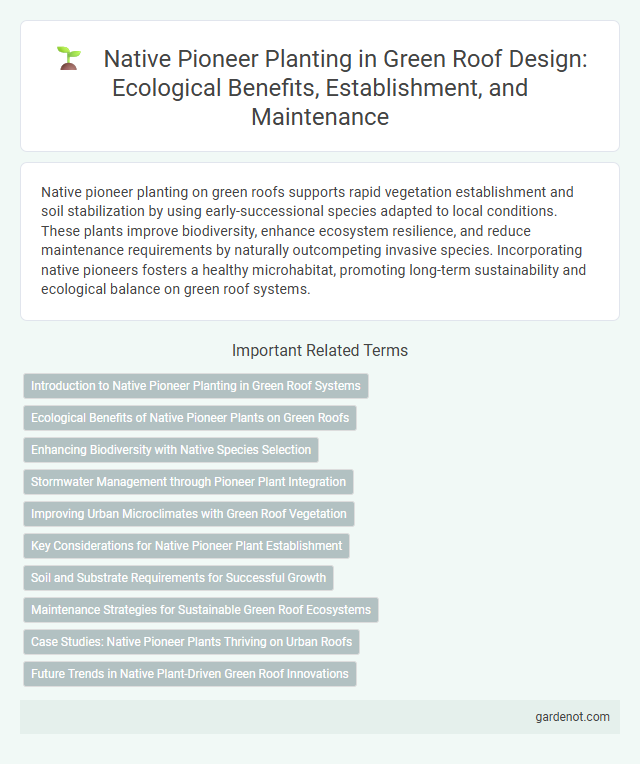Native pioneer planting on green roofs supports rapid vegetation establishment and soil stabilization by using early-successional species adapted to local conditions. These plants improve biodiversity, enhance ecosystem resilience, and reduce maintenance requirements by naturally outcompeting invasive species. Incorporating native pioneers fosters a healthy microhabitat, promoting long-term sustainability and ecological balance on green roof systems.
Introduction to Native Pioneer Planting in Green Roof Systems
Native pioneer planting in green roof systems involves selecting hardy, drought-tolerant species that establish quickly and improve substrate stability. These pioneer plants, such as Sedum, native grasses, and wildflowers, enhance biodiversity and create a foundation for subsequent vegetation layers. Integrating native pioneers accelerates ecosystem development, supports pollinators, and reduces maintenance needs in green roof installations.
Ecological Benefits of Native Pioneer Plants on Green Roofs
Native pioneer plants on green roofs enhance ecological resilience by stabilizing soil, reducing erosion, and improving water retention through their deep root systems. Their ability to adapt to harsh rooftop conditions supports biodiversity by providing habitat and food sources for pollinators and other native wildlife. These plants also facilitate the gradual succession of vegetation, promoting a self-sustaining ecosystem that contributes to urban heat island mitigation and carbon sequestration.
Enhancing Biodiversity with Native Species Selection
Selecting native pioneer plants for green roofs significantly enhances urban biodiversity by providing essential habitats for local pollinators and wildlife. These hardy species establish quickly, improve soil health, and create a stable ecosystem that supports a diverse range of flora and fauna. Incorporating native plants promotes ecological balance and resilience in green roof environments, fostering sustainable urban green spaces.
Stormwater Management through Pioneer Plant Integration
Native pioneer plants play a crucial role in green roof stormwater management by rapidly establishing vegetation cover that enhances water absorption and reduces runoff. These species, adapted to local climates, improve soil structure and increase infiltration rates, minimizing surface water accumulation and promoting natural filtration. Integrating pioneer plants into green roofs supports sustainable urban water management by stabilizing substrates and reducing the burden on municipal drainage systems.
Improving Urban Microclimates with Green Roof Vegetation
Native pioneer plants on green roofs enhance urban microclimates by increasing evapotranspiration and reducing surface temperatures, mitigating the urban heat island effect. Their deep root systems improve soil structure and water retention, promoting biodiversity and stormwater management. Selecting indigenous pioneer species ensures resilience, rapid establishment, and ecological balance in urban environments.
Key Considerations for Native Pioneer Plant Establishment
Native pioneer plants for green roofs require careful selection based on drought tolerance, root structure, and growth rate to ensure successful establishment. Soil composition and depth must support nutrient availability and moisture retention while facilitating proper drainage to prevent root rot. Monitoring microclimate factors such as sun exposure and wind is crucial for aiding native pioneer species in adapting and thriving on green roofs.
Soil and Substrate Requirements for Successful Growth
Native pioneer plants on green roofs require well-draining, lightweight substrates enriched with organic matter to support root development and moisture retention. Optimal soil pH ranges between 6.0 and 7.0, ensuring nutrient availability and microbial activity essential for plant establishment. Incorporating porous materials like expanded shale or volcanic rock enhances aeration while maintaining adequate water-holding capacity for sustainable growth.
Maintenance Strategies for Sustainable Green Roof Ecosystems
Native pioneer plants on green roofs establish resilient early-stage ecosystems by enhancing soil stability and promoting biodiversity. Effective maintenance strategies include regular monitoring for invasive species, minimal irrigation tailored to native species' drought tolerance, and selective pruning to encourage healthy growth. Integrating seasonal inspections and adaptive maintenance schedules optimizes sustainable performance and long-term ecological balance on green roofs.
Case Studies: Native Pioneer Plants Thriving on Urban Roofs
Native pioneer plants such as Sedum species, Eriophyllum lanatum, and Lupinus nanus have demonstrated remarkable adaptability and resilience in urban green roof environments, promoting biodiversity and improving ecological stability. Case studies in cities like Portland and Chicago reveal these species' ability to thrive in shallow substrates with limited water, enhancing stormwater management and urban heat island mitigation. Their successful establishment on rooftops supports native pollinators and contributes to sustainable urban ecosystem restoration.
Future Trends in Native Plant-Driven Green Roof Innovations
Native pioneer planting on green roofs is advancing with a focus on resilient, drought-tolerant species that enhance biodiversity and ecological function. Emerging trends emphasize the integration of native wildflowers and grasses that improve soil health and support pollinator habitats in urban environments. Innovations include bioengineered seed mixes tailored for harsh rooftop conditions, optimizing plant establishment and long-term sustainability.
Native pioneer planting Infographic

 gardenot.com
gardenot.com